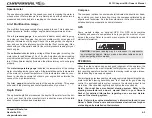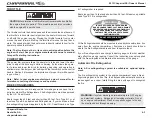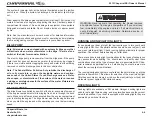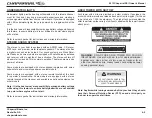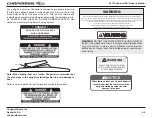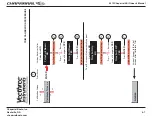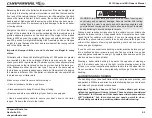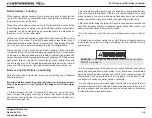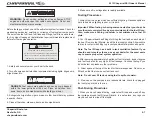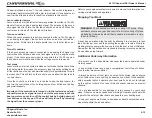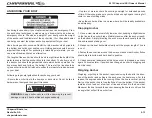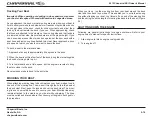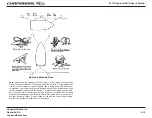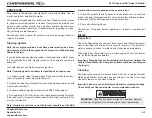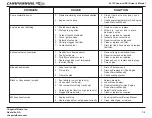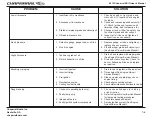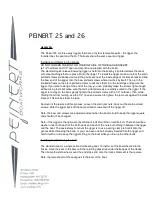
2013 Chaparral SSi Owner’s Manual
Chaparral Boats, Inc.
Nashville, GA
chaparralboats.com
5-8
2. Open engine compartment and all hatches, windows, doors and com-
partments closed during fueling. Inspect these areas for fuel fumes or
fuel line leakage visually and by smelling. Check out any sign of fuel
leakage or any indication of fumes and correct problem before starting
the engine.
3. Run bilge blower at least four minutes before restarting engine to ven-
tilate engine compartment.
OPERATING YOUR BOAT
Starting the Engine
Important: Falls from moving boats are a major cause of fatal rec-
reational boating accidents. Do not allow passengers to ride on the
bow with feet hanging over the side or ride while sitting on the stern,
gunwales, or seat backs. The Coast Guard considers these acts to
be negligent or grossly negligent operation and prohibits them by
law.
The following information is only a general guide. Chapter 4 has specifi c
starting instructions for boats with battery selector switches. Detailed in-
structions are also in the engine owner’s manual. Be sure to read and
follow all of those instructions.
1. Secure boat to the dock or mooring slip before attempting to start en-
gine. Keep boat secure until engine is running and warmed up.
2. Check lubricating fl uid levels. Check fuel supply to make sure you have
enough fuel for your planned excursion.
DANGER: Carbon Monoxide Hazard!
A cold engine pro-
duces more carbon monoxide than a warm engine. Provide
adequate ventilation in the cabin and cockpit to prevent expo-
sure and reduce the possibility of carbon monoxide
accumulation. Open all hatches, doors, windows, and side
vents to increase air movement.
3. To prevent an explosion or fi re, look for leaks in fuel, oil, coolant, ex-
haust, and power steering systems. Be aware of any odors of these fl u-
ids.
DANGER:
Gasoline vapors are highly explosive. Run bilge
blower for at least 4 minutes before starting engine. Check engine
and fuel compartments for fumes or accumulation of fuel.
4. Make sure the throttle is in the neutral position.
5. Start the engine. Refer to your engine owner’s manual for recommend-
ed procedures for break-in, service, and other related operation.
6. Turn ignition key to START. Release key and allow to return to RUN
after engine starts. If engine fails to start, wait one minute. Move throttle
only once to maximum position then back to the neutral position. Try to
start engine again.
Note: Transmission must be in neutral position before engine will
turn over.
Important: Do not operate starter continuously for more than 15
seconds without pausing. Allow starter to cool at least three min-
utes between start attempts.
7. Warm up a cold engine by running it at fast idle speed (as recom-
mended in engine manual) approximately one to two minutes.
Leaving the Dock
After the engine has warmed up, you are ready to leave the dock. Be-
fore you cast off, check all gauges, particularly the oil pressure gauge,
for proper readings. Check the operation of the steering by turning the
steering wheel to full port and to full starboard while observing outdrive
movement. Check that charging system is working properly. Check again
for fuel, oil, and exhaust leaks.


